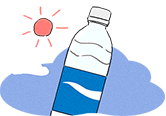People who have a higher risk of suffering heat disorders
Children and the elderly tend to be the most susceptible to heat disorders. Particular care should be taken on hot days and at the beginning of the rainy season.
Children
Children's sweat glands are immature and their body temperature is not well regulated
Compared to adults, infants and toddlers have a higher body temperature because they have a more active metabolism.
Furthermore, the development of their sweat glands is not complete and they cannot regulate their body temperature well. In places where the environmental temperature is hotter than the body temperature, such as in a hot car, their body temperature can rise in a short period to a life-threatening level.
Caution necessary when going outside
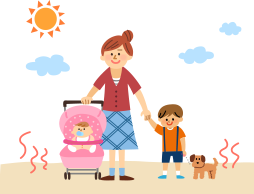
Caution is also necessary when going outside on hot days. On sunny days, the closer you are to the ground, the hotter it is. For instance, when the temperature outside is 32℃, it is 35℃ at 50 cm above the ground and 36℃ or more at 5 cm above the ground. When going out with an infant in a stroller, be sure to check them frequently.
Tips for preventing heat disorders in young children
- 1Keep an eye on children, and if their faces are flushed and they are sweating profusely, move them to a cool location and have them rest.
- 2Teach them about proper hydration
It's important that they learn to drink enough when they feel thirsty. - 3Get them acclimatized to the heat by letting them play outside on a regular basis.
- 4Choose appropriate clothing
Parents and guardians should help young children choose appropriate clothing, and ensure that they know when to remove or add layers in response to changing temperatures.
Source: Ministry of the Environment, Environmental Health Department, Environmental Health and Safety Division. Heat Disorders Environmental Health Manual (March 2014 Revised Edition)
The elderly
A general decline in bodily functions puts the elderly at particular risk of heat disorders
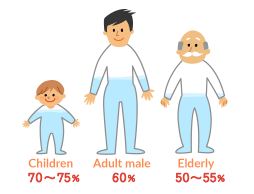
As people age, their level of body fat tends to increase, and the proportion of their body that is water - their body water content - tends to decrease. Therefore, an elderly person placed in the same environment as a non-elderly person will be more likely to develop heat disorders. The elderly are also less likely to notice the heat or become thirsty, and are therefore less likely to drink enough water. In addition, because the elderly have decreased heart and/or liver function, if they develop heat disorders, their symptoms are more likely to become serious.
Recommended preventative measures for the elderly
- Rehydrate even when not thirsty
- Check the room temperature frequently
- Exercise enough to work up a sweat once a day
Source: Ministry of the Environment, Environmental Health Department, Environmental Health and Safety Division. Heat Disorders Environmental Health Manual (March 2014 Revised Edition)
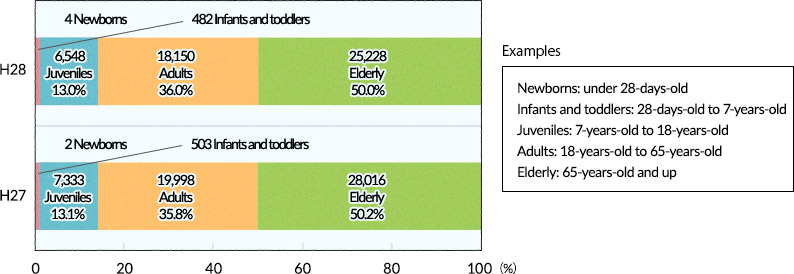
It may be too late to drink just when you feel thirsty
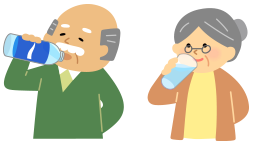
The elderly are at particular risk of heat disorders because of the following factors.
- Less likely to feel the heat and the thirst
- More likely to not have enough fluid in the body
- Temperature control tends to be delayed, and heat is likely to be trapped inside the body
- The amount of water drunk decreases in line with the decrease in meal volumes.
- Tend to keep liquid intake low as to avoid having to go to the toilet often
It is important for the elderly to pay attention to their physical conditions and get an adequate amount of water and salt (sodium).
Monitor the indoor environment
One feature of heat disorders in the elderly is that is often occurs indoors. In addition to taking steps to ensure that the indoor temperature does not increase, the temperature should be checked regularly. Also, because the elderly are less likely to feel thirsty, they must be careful to drink enough water. The elderly must be extremely careful to avoid heat disorders particularly when exercising.
Heat-Related Fatalities in 2010
| Location | Number of Fatalities |
|---|---|
| Total | 1718 |
| Home (yard) | 783 |
| Residential facility | 3 |
| School, facility, or public area | 3 |
| Sports and competition facilities | 3 |
| Streets and highways | 20 |
| Business and service facilities | 5 |
| Industrial areas and construction sites | 19 |
| Farms | 62 |
| Other clearly identified locations | 46 |
| Details unknown | 774 |
Source: Ministry of Health, Labour and Welfare. Heat-Related Fatalities in 2010
Tips for preventing heat disorders in the elderly
- Rehydrate frequently
- Cool the body with a shower and damp towels
- Do not overdo it when it is hot
- Ensure good indoor airflow
- Use air conditioning and fans effectively
- Monitor the indoor temperature
- Wear cool clothing
- Know who to contact in case of emergency
Source: Ministry of the Environment, Environmental Policy Bureau, Environmental Health Department, Environmental Health and Safety Division. "Do You Know About Heat disorders?"
- People who are overweight or obese, people with low physical strength, people with low endurance, and people who are not acclimatized to the heat
Seven out of ten heat-related deaths that occur in schools occur in obese students. When there is more subcutaneous fat, heat does not escape from the body as easily, and more heat is produced in moving a heavier body. In addition, people with less strength and endurance are more susceptible to the heat, and need to be more careful. - First-year students in junior high school and high school sports clubs
Students who are not yet accustomed to exercise and are not as familiar with the conditions of their own bodies are more likely to overdo it. Heat disorders are therefore particularly common among first-year students in junior high school and high school. - People who are in poor physical condition
The temperature regulation systems of people who are in poor physical condition because of a lack of sleep or fatigue, and people who have less water in their bodies because of diarrhea or drinking too much alcohol the night before, are not functioning normally, and these people are therefore at higher risk of developing heat disorders. - People with pre-existing diseases and people who have previously had heat stroke
People being treated for diabetes, hypertension, heart disease, kidney failure, psychiatric disorders, or extensive skin disorders are known to be more likely to develop heat disorders. People who have developed heat disorders before also need to be more careful.
Case studies highlighting situations in which extra attention should be paid and action taken to prevent heat disorders, such as during sports activities and in the workplace.






